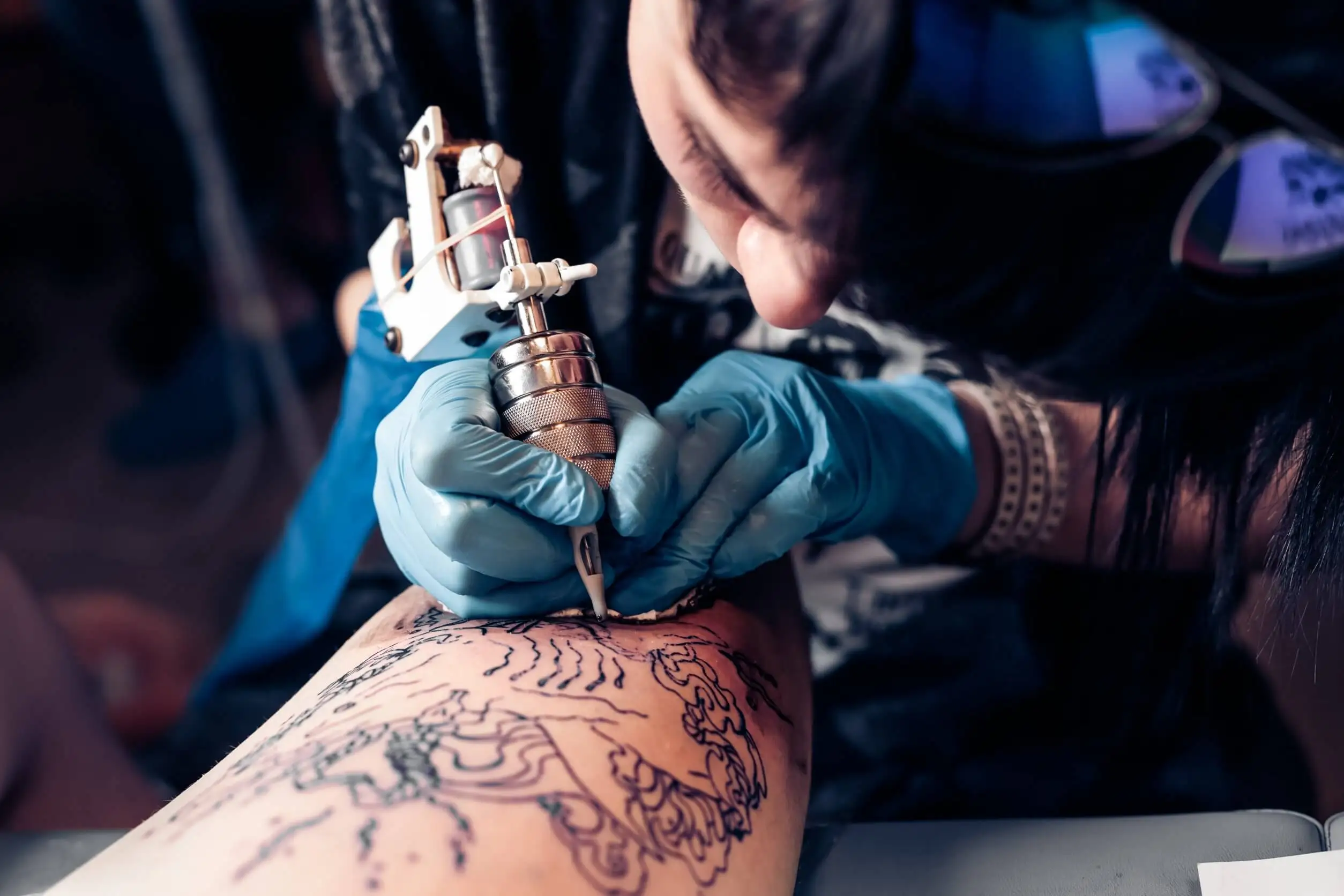Temporary Tattoos: What Are They and What Are Their Risks?


Reviewed and approved by the doctor Leonardo Biolatto
The fashion of temporary tattoos is part of the current trends of decorating the body with different elements, and there are several ways to do it.
Unlike permanent tattoos, temporary tattoos don’t involve the use of needles or cause wounds, but are more superficial. For this reason, you might think that they carry no risks or side effects. But this isn’t so. Let’s take a closer look.
The differences between temporary and permanent tattoos
Temporary tattoos are decorative designs that are painted on the skin using different types of inks. They only penetrate the most superficial layer, although they can be just as colorful and eye-catching.
They are so-called because they last from a few days to a few weeks. This is unlike those done with needles, in which the ink is injected into deeper layers of the skin to capture the design.
Among the main differences between one and another form of tattooing we have the following:
- In general, the whole process with temporary tattoos is easier, faster, and less painful.
- They don’t require the same amount of care as permanent tattoos.
- The fact that temporary tattoos don’t remain on the skin is an advantage, since no procedure is needed to remove them.
- Additionally, the person can use it to test how they would look with a certain design. Then, if desired, a tattoo can be done permanently.
- For temporary tattoos, there’s no need to use a professional artist. You can even do it on your own at home.
- Finally, permanent tattoos are usually much more expensive, both in the initial investment and in the aftercare.

We think you may also enjoy reading this article: 4 Foods to Avoid Eating After Getting a Tattoo
Different types of temporary tattoos
Depending on the materials used, there are several types of temporary tattoos. First, you have the decal ones; these are self-adhesive designs that come ready to place. Sometimes, you just need to moisten a little bit and that’s it. Secondly, there are the ones made with natural inks.
You can buy kits to make this type of temporary tattoos, including templates with generic motifs. Finally, there are those that are done with black henna, which are the most used, because the resulting color is intense. This dye comes from the Lawsonia inermis plant, which also has medicinal applications.
What to take into account when getting a temporary tattoo
It’s always advisable to go to a professional. She or he will know how to do a better job by offering a variety of designs and giving advice to avoid problems. But if you want to get a temporary tattoo at home, you can take into account the following recommendations:
- The first thing is to choose the area where it’s easiest to work. If you’re going to do it on your back, you will need help.
- Remember that it’s best to buy natural ink.
- Apply a little on a small area of the skin first to make sure it won’t cause a reaction.
- Then you should clean, wash, and dry the area well, so that the ink will set. Shaving and even exfoliating are also recommended.
- Paste the stencil of the design you have chosen and follow the lines with the tool included in the kit.
- Try not to apply more ink than necessary.
- Wait for it to dry well before wetting the area. You can use talcum powder to help with this task. But avoid washing with strong soaps if you want the tattoo to last a little longer.
- You can apply petroleum jelly to protect the drawing.
Like this article? You may also like to read: What Are the Risks of Using Black Henna for Tattoos?
The risks and side effects of temporary tattoos
While not using needles reduces the chances of infection, temporary tattoos are not without risks, as they can still cause allergic reactions and other skin problems. This even happens with stickers, which are very popular among children.
In this regard, according to a study conducted by the University of Granada (UGR), these stickers can affect the function of the protective epidermal barrier. The research compared the dermatological effects of adhesive temporary tattoos and permanent tattoos. The decals were found to be more detrimental in terms of variables such as stratum corneum hydration and antioxidant capacity.
While perms have other risks, such as infections and scarring problems, they don’t cause such adverse skin effects. In fact, it’s considered that tattooed and non-tattooed skin can perspire equally well.
On the other hand, there have also been warnings about the risks of black henna for temporary tattoos. This ink, despite being of natural origin, has a high content of paraphenylenediamine, a substance banned by the European Union Health Council.
Furthermore, according to the Spanish Agency for Medicines and Health Products (AEMPS), black henna can cause severe allergic skin reactions and permanent sensitization.
However, all this can also occur with other inks, in which harmful substances (heavy metals and amines) have been found. Among the effects observed are the following:
- Itching
- Blistering
- Oozing
- Reddening
- Depigmentation
In particular, it’s known that children are more susceptible to experiencing these consequences. This is established by research published by the Spanish Association of Pediatrics (AEP).

Precautionary measures to keep in mind
Tattoos, whether temporary or permanent, are not exempt from complications. Therefore, precautions should be taken before, during, and after tattooing.
It’s important to remember that the skin of babies and children, in general, isn’t like that of adults and can be more delicate. So don’t take this lightly.
On the other hand, before getting a tattoo of any kind, you should seek information about the possible risks and, above all, know if you are allergic to henna or to any component of the ink. Preferably, you should opt for products such as natural henna or inks without toxic chemicals.
Also, if you don’t do it at home, go to a place that maintains adequate hygienic conditions. Certify that the site is authorized by a competent body in your country or region.
All cited sources were thoroughly reviewed by our team to ensure their quality, reliability, currency, and validity. The bibliography of this article was considered reliable and of academic or scientific accuracy.
- Arranz Sánchez D, Corral de la Calle M, Vidaurrázaga C, de Lucas R, Díaz Díaz R. Riesgos de los tatuajes de henna negra. Anales de Pediatría. DOI: 10.1157/13080412.
- Chaudhary G, Goyal S, Poonia P. Lawsonia inermis Linnaeus: A Phytopharmacological Review. International Journal of Pharmaceutical Sciences and Drug Research. 2010; 2(2): 91-98
- Córdoba S, Dorado J, Sánchez-Pérez J, et al. Dermatitis de contacto por pseudotatuaje de henna negra. Actas Dermo-Sifiliográficas. 95(10) 618-621.
- Hervella M, Durán G, Iglesias M, Ros C, Gallego M. Reasons to advise against temporary henna tattoos. Anales Sis San Navarra. 2005; 28(3): 403-407.
- Jurado Palomo J, Martín Muñoz M, Bobolea I, Fiandor Román A. Dermatitis de contacto por tatuajes temporales en niños. An Pediatr (Barc). 2008; 68: 309-310. DOI: 10.1157/13116720.
- Serrano-Serra J, Montero-Vilchez T, Buendia-Eisman A, Arias-Santiago S. Epidermal Barrier Function and Skin Homeostasis in Skin with Permanent and Adhesive Tattoos: A Cross-Sectional Study. Journal of Clinical Medicine. 2021; 10(4): 888.
This text is provided for informational purposes only and does not replace consultation with a professional. If in doubt, consult your specialist.








